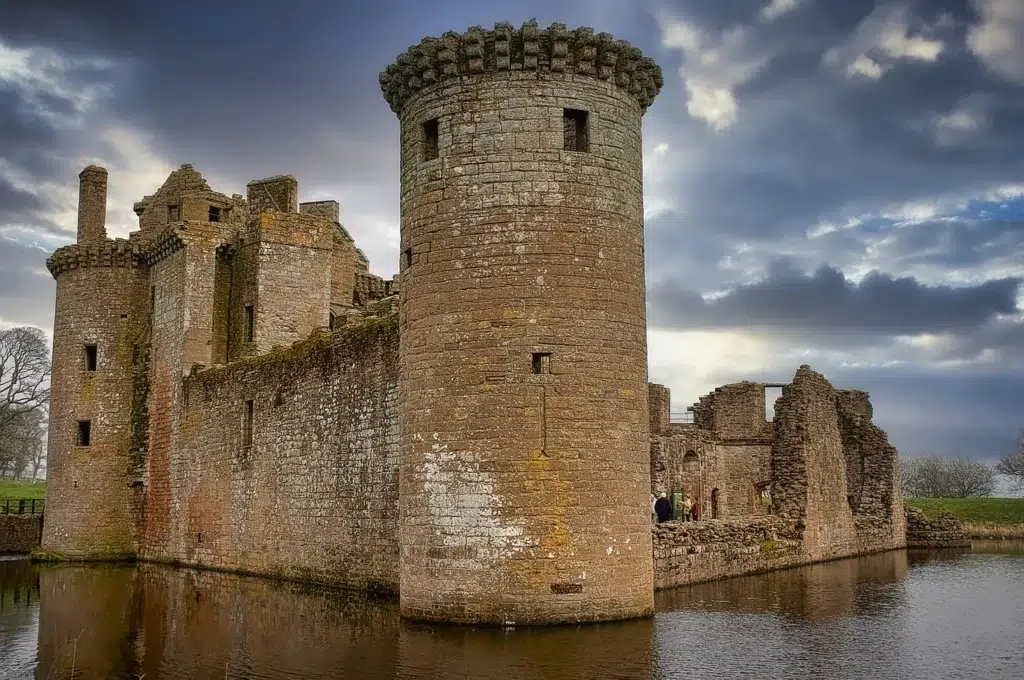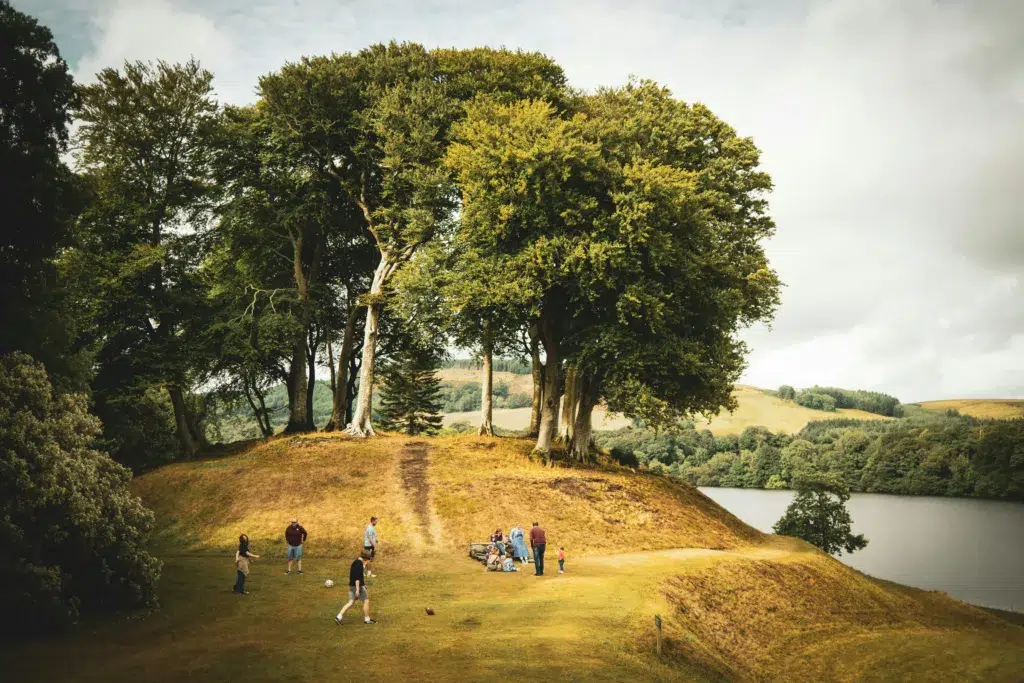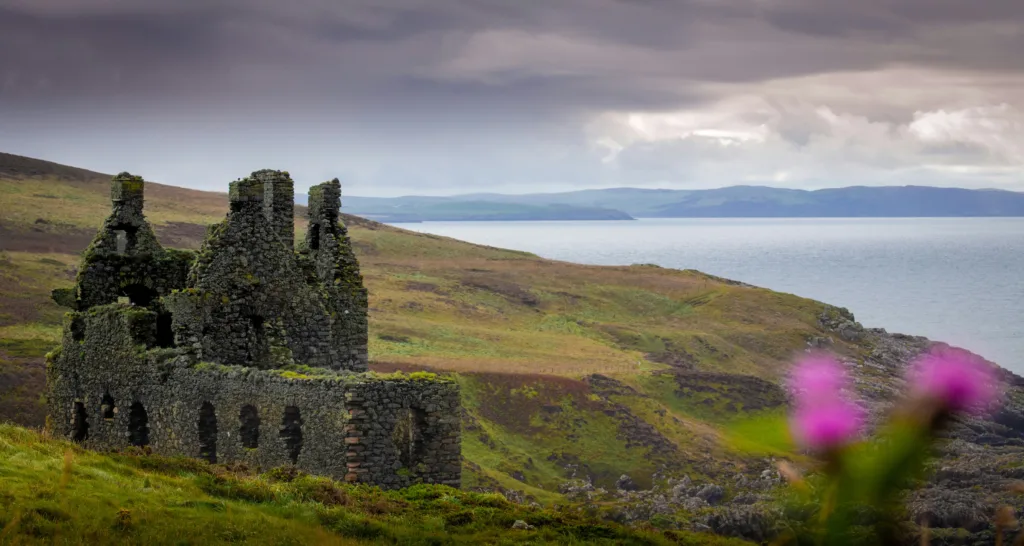16 Great Castles In Dumfries and Galloway
Dumfries and Galloway is a very beautiful part of Scotland. This post will list the best castles in Dumfries and Galloway from old forts to medieval tower houses, gardens and museums.
From timeless villages to conserved bays, deep forests, glens, rivers and loch, there is so much to explore. Moreover, the main highlights of Dumfries and Galloway is the many fine historic Scottish Castles and imposing castle ruins.

Caerlaverock Castle
Caerlaverock Castle is a ruined castle with a visitor’s centre and a cafe. The structure is a brilliant example of a triangular-moated twin-towered medieval stronghold.
Standing on the northern edge of the Solway Firth, beside the River Nith. Caerlaverock Castle is now cared for by Historic Environment Scotland.
For over four centuries the castle was home to the powerful Maxwell family. Sir John De Maccuswell was granted the land in 1220 and the castle was completed in the 1270s.
Herbert Maxwell, son of Sir Aymer and nephew of Sit John occupied the castle for a few decades.
This castle has had a turbulent history, and was involved in the Wars of Independence also straight after it was built. Between 1299 and 1634, the castle was besieged, captured, recaptured and changed hands between the Scottish and the English through sporadic and bloody battles.
Resulting of these turbulent periods, damage occurred to Caelaverlock Castle and it was never fixed. Therefore, Lord Robert Maxwell fled to the Isle of Man in 1640 where he spent the rest of his life.
Cardoness Castle
Built-in the late 15th century by the McCulloch lairds. The McCullochs lost the castle to a family enemy in the late 17th century after Sir Godfrey McCulloch was executed for killing a member of Clan Gordon.
The castle is located near Castle Douglas and is a fine example of a six-story Scottish tower-house castle.
This type of tower house was so favoured by nobility throughout Scotland during this period. There is a spiral staircase connecting several floors and a basement.
Due to the location of the castle on a steep hill, you will be rewarded with views across Fleet Bay and to the Solway Firth beyond. It stands beside the busy A75, seemingly immune to the traffic scurrying below.
Carsluith Castle
Located just off the busy A75, just south of Creetown, across the bay from Wigtown. Dating back to the 16th century, this is an L-shaped tower house, and it is in a good state of preservation.
James Lindsay, Chamberlain of Galloway, built the original rectangular structure in the 15th century. In 1513, James Lindsay’son was killed at Flodden, therefore the castle was passed by marriage to Richard Brown.
The site is currently managed by Historic Environment Scotland. The castle is currently closed, however, there is a good cafe place pretty much located in the courtyard of the castle.

Castle Kennedy Gardens
The gardens at Castle Kennedy is one of the most famous in Scotland. Loch side landscapes has been designed spectacularly.
There are stunning fauna, to beautiful scenery, sculpted landforms, spectacular walks and popular bird hides. The gardens are definitely a hidden gem in the southwest of Scotland.
The colourful display of flowers, rare exotic plants and champion trees are glowing. Also, visitors can view the walled garden, atmospheric avenues and romantic ruins of the 16th century Castle Kennedy.
A unique experiences that visitors must enjoy is the open air theatre against the dramatic backdrop of the castle ruin. Also, there is a tearoom with picnic tables outside, a popular plant centre and dogs are welcome.
Castle of St John
The Castle of St John is also known as Stranraer Castle, is an early 16th century L-plan tower house in the centre of Stranraer in Dumfries and Galloway.
One of the most powerful Lairds of Wigtownshire, Ninian Adair of Kilhurst, built this medieval tower house.
At the castle, you can learn about the about the Killing Ties in the 1680s, where the Government troops who used the castle as there headquarters.
Also, you can learn about the criminals and debtors who were imprisoned in the castle during the 19th century. There are videos and reconstructions which tell the story of the medieval landowners who built and lived in the castle.
Drumcoltran Tower
A 16th-century tower house which is built on the south facing slop overlooking the Kirkgunzeon Lane, a burn which flows into the Urr Water at Dalbeatie.
The tower stands in a farmyard setting and has been a farm store for many years. The tower house was built by the Maxwell Clan.
It is a little off the beaten track, but it is well worth the effort.
At the end of a single track road there is a small lay by which is big enough to fit two cars. The outside is in excellent condition for its age.

Drumlanrig Castle
The home of the 10th Duke and Duchess of Buccleuch and Queensberry. The castle is set in a stunning garden within a vast 90,000-acre country estate.
The land was given to the 1st Duke of Buccleuch by Robert the Bruce. It is said that the Duke was inspired to build the ancestral home in this location due to the spectacular views across Nith Valley.
This castle took 10 years to build, which was a great expense, even for a duke.
Drumlanrig is built from red sandstone and is known locally as the “The Pink Palace”, it is one of the finest examples of Renaissance architecture.
Some people might recognise the castle from a scene in the second series of Outlander.

Dunskey Castle
A ruined 16th-century L-plan tower house on the site of 14th-century Adair Castle. Located about a mile south of Portpatrick, standing in a marvellous position on the head of a rocky promontory, overlooking the Irish Sea.
The Adair family built this castle, also, the family built the Castle of St John in Stranraer.
An extension was added to the north in the 1620s. However, by the turn of the 18th century, the whole building was derelict.
Dunskey Castle is located on the coastal path from Portpatrick. Unfortunately, there is no access to the castle interior.
I can not advise on going near the castle, extra care needs to be taken. The cliffs here are steep and dangerous, thus is is important to stick to the path.
MacLellan’s Castle
Located in the centre of Kirkcudbright is the 16th-century ruin of MacLellan’s castle. Sir Thomas MacLellan of Bombie, Provost of Kirkcudbright demolished the previous medieval Greyfriars convent and started to build MacLellan’s Castle in 1577.
The purpose of the castle was entertaining guests. The upper floors had areas for socialising and guest bedrooms.
While the lower levels had a kitchen and great hall It is an L-plan castle consisting of two wings meeting at right angles.
The family sold the castle in 1752, and from 1782 to 1912 the Earls of Selkirk held the castle. The castle is fairly well preserved and is only missing its roof.
Sometimes, the castle is also known as Kirkcudbright Castle. Now, the castle is cared for by Historic Environment Scotland.
Morton Castle
Often cited as the best-kept secret in Scotland, due to its location and lack of signposts. The road leading to the castle is unmarked and there is a single track to follow.
Morton Castle is set in a tranquil setting, and the beauty of the area makes it well worth searching for the ruins.
Morton Castle is a 13th-century castle ruin which sits on the high ground amongst the Lowther Hills, on the shores of Morton Loch.
All that is left of the castle is a rectangular two-storey block. This is believed to have been an impressive gatehouse and a circular tower with a pit prison below.
This castle has an extensive history. It was one of the strongholds which were dismantled under the terms of the 1357 Treaty of Berwick between England and Scotland.
However, Morton Castle was built again in the 15th century. From 1459, it was a stronghold for the Douglas family and it was occupied until 1715.
Orchardton Tower
Strikingly well-preserved 15th-century tower house – Orchardton Tower is located in Castle Douglas. The tower an unusual free-standing round tower, the only one of its type in Scotland.
This style of castle was popular in the 1200s, however, nobleman John Cairns, decided to build himself a round tower 200 years after they have gone out of fashion.
This is a very historical, calm and serene setting, tucked away in a narrow lane.
Parking is free and normally not busy. It does not take long to explore here, can easily be seen wile stopping between other places.
Sanquhar Castle
The ruins of the 13th-century Sanquhar Castle are very impressive. I often try to imagine what life would have been like for those who lived there long ago.
There is evidence of what used to be a courtyard and towers.
This structure was once an important stronghold for the powerful Crichton family. Back in medieval times, many Kings and Queens including Edward I, Mary Queen of Scots and James VI have been noted to visit the castle.
Also, reports have suggested that Robert the Bruce and William Wallace visited the castle. Marquis of Bute, Lord Sanquhar is in ownership of the castle now.
Also, it is said that Sanquhar Castle is haunted by ghosts. These are the “White Lady” and the ghost of John Wilson who was reportedly wrongly killed by the Crichtons.
Due to the building being severely ruined, it can be dangerous. Therefore, I can not recommend going into the ruins, however, they can be enjoyed from a distance.
It is easy to see the castle by approaching it from the A76 road on the southern outskirts of Sanquhar.
Sorbie Tower
Sorbie Tower is a late 16th-century tower house hidden in a wooded area just off the B7052 between Garlieston and Sorbie village. In 1677, the tower was sold to Earl of Galloway and by 1748 the tower was left in ruin.
This is a lovely atmospheric castle, where it great to have a picnic. Renovations are currently ongoing, so you can not get inside but it is great to view from the outside.
Also, the tower is close to the castle is a large mound of ground which is known as Sorbie Motte. This is believed to be where a 12th-century Pictish fort was erected by the Vipont family.
Threave Castle
In 1369, Archibald ‘the grim’ built Threave Castle as a stronghold for the Black Douglases. Threave Castle is a tower house that stands 30 metres tall, and it is pretty much still intact.
Considering the fortified island’s locations, marshy surroundings and countless attacks over the centuries, it is surprising that the structure is still standing.
As the castle is located on an island, a half of mile walk to the ferry is required on good way marked paths.
At the small jetty, there is a brass bell with a rope attached. Once you send the bell loudly, a boatman will come across from the island to take you to the castle on a short and rather romantic boat ride across the River Dee.
The island on which Threave Castle is perched was a lot smaller hundreds of years ago than it is today. This is because the water level has decreased.
During Napoleonic War, the Threave Castle was used as a prison for French prisoners. The castle is currently cared for by Historic Environment Scotland.
How many castles are in Dumfries and Galloway?
There are 95 castles in Dumfries and Galloway. Some of the buildings are now residences or on private land and should not be accessed.
Others are castle ruins that have not much left to view. The castles listed in this article are mostly well-preserved and are accessible to the public.
Final note
I hope this guide has suggested some epic castles in Dumfries and Galloway. This area is full of history and many famous figures including Robert the Bruce, William Wallace, Kings and queens of Scotland have resided in these castles.
Visiting one of these castles is great for lovely serene settings, great photo opportunities and places to relax and recharge.
Many of the castles in Dumfries and Galloway can be visited on the South West Coastal 300. There are plenty of fairytale castles to explore all over the country near Perth, Aberdeen, Glasgow, Edinburgh and in Argyll and Bute.
The following two last suggestions are crumbling ruins, there is not much left to see. The conditions of the remains of the structures is very bad and it can be dangerous.
- Lochmaben Castle is a late 13th-century castle ruin. The shattered remains was built by the English occupying force in the 1300s. The locations is lovely, situated among attractive woodland next to a loch.
- Finally, one last castle to visit is the ruins of Torthorwald Castle. This castle has a 24-metre-high ruined tower and a courtyard. It is located in the centre of the village of Torthorwald, not far from the A709.
